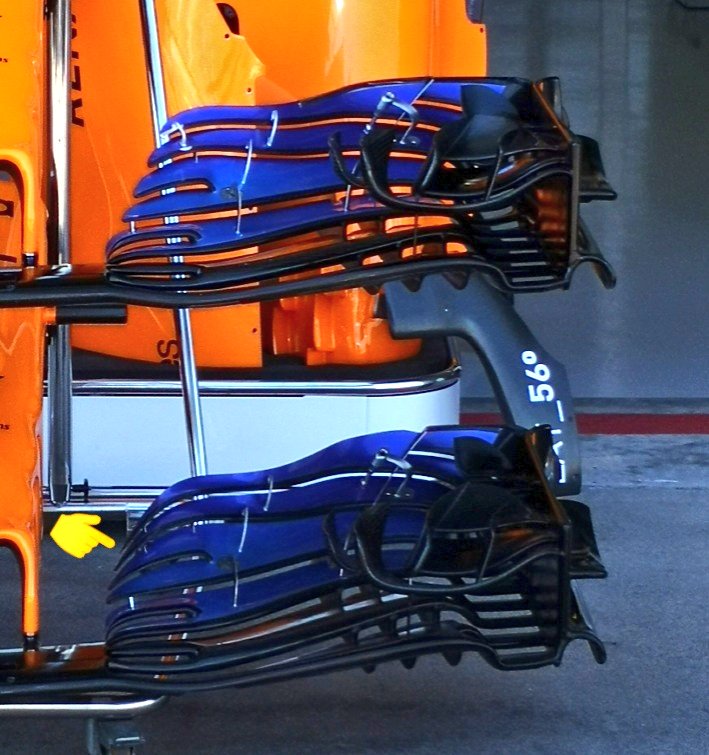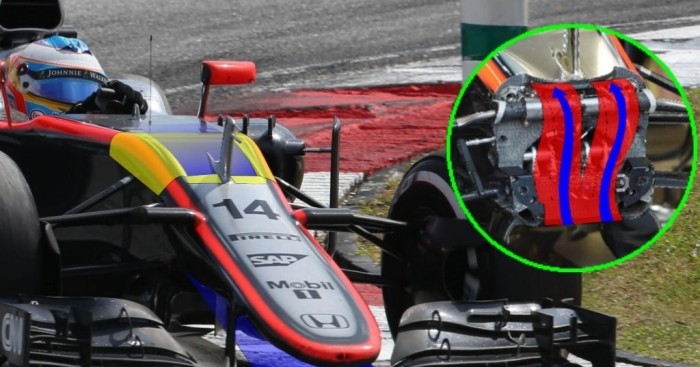back to back testing and spares , fingers crossed you dont smash up the new car so many times you have to use the old stuff
- Login or Register
No account yet? Sign up
back to back testing and spares , fingers crossed you dont smash up the new car so many times you have to use the old stuff
anyone thought about the s-duct not being useful with having halo in it‘s potential streamlines?Macklaren wrote:Still no S-duct?
I think the purpose of the s duct is to renew the boundary layer below the nose.

Doesn't the boundary layer just immediately start to build again? I always thought the main purpose of the S-Duct was to scoop up the air that was wrapping around the nose from the top around to the bottom in hopes of eliminating any higher pressure flow. Also, if it was all about the boundary layer, wouldn't they want to vent the B.L. from the sides of the nose too as this air is really what interacts with the bargeboards?ArgyrisB wrote: ↑22 Mar 2018, 01:36I think the purpose of the s duct is to renew the boundary layer below the nose.
As the air travels below the nose the boundary layer thickens, meaning more air losing its energy. So the duct scoops the low energy air and puts it above the nose.
High energy air under the nose to feed the diffuser.
Low energy air above the nose --> no harm done.
Sort of the way wind tunnel trims the boundary layer:
http://rockets2sprockets.com/wp-content ... mobile.jpg
If that was the case, I think we'd see more standard solutions for s-duct intakes. What we see are very similar outlets and varied solutions for the intakes, including naca ducts which I believe wouldn't be very efficient to 'renew' the boundary layer.ArgyrisB wrote: ↑22 Mar 2018, 01:36I think the purpose of the s duct is to renew the boundary layer below the nose.
As the air travels below the nose the boundary layer thickens, meaning more air losing its energy. So the duct scoops the low energy air and puts it above the nose.
High energy air under the nose to feed the diffuser.
Low energy air above the nose --> no harm done.
Sort of the way wind tunnel trims the boundary layer:
http://rockets2sprockets.com/wp-content ... mobile.jpg


The upper one is the low DF wing. Last year in some races ALO used the lower downforce wing and Stoffel used the higher downforce wing, I can remember Malaysia from the top of my head.Morteza wrote: ↑22 Mar 2018, 05:57They have brought two different front wings
https://pbs.twimg.com/media/DY3Rx6lVwAAsVGM.jpg
Via @AlbertFabrega
I think that wind tunnel example is misleading. In a wind tunnel you want to prevent the effects of flow constriction causing a higher mean velocity than intended around the test subject. i.e. as the boundary layer thickens the flow in the "middle" has to increase in velocity due to conservation of mass.ArgyrisB wrote: ↑22 Mar 2018, 01:36I think the purpose of the s duct is to renew the boundary layer below the nose.
As the air travels below the nose the boundary layer thickens, meaning more air losing its energy. So the duct scoops the low energy air and puts it above the nose.
High energy air under the nose to feed the diffuser.
Low energy air above the nose --> no harm done.
Sort of the way wind tunnel trims the boundary layer:
http://rockets2sprockets.com/wp-content ... mobile.jpg

For those unfamiliar with the 'S' duct, put simply it takes airflow from the underside of the nose/chassis and ejects on the upper surface of the chassis, attracting the surrounding airflow which may have otherwise detached (owing to the slope angle of the nose/chassis) to reattach (Coanda effect)
...
An S-duct reduces drag by energizing the flow around the step in the nose. This is a good explanation. Be sure to check all three pages:
http://en.f1i.com/magazine/8277-tech-an ... -duct.html